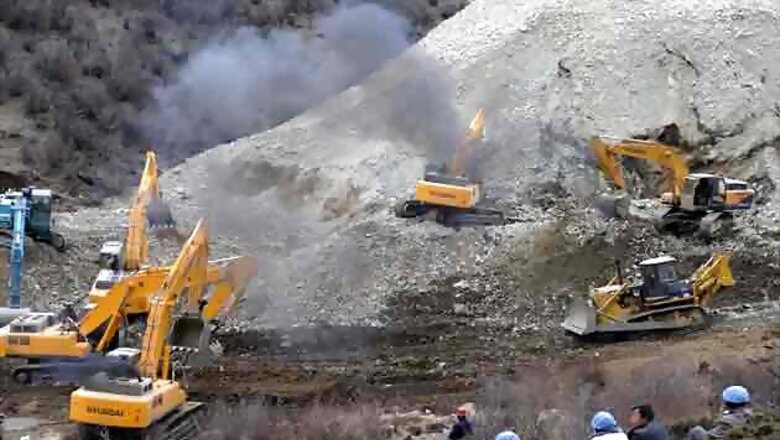
views
Beijing: The massive landslide that engulfed a gold mine in Tibet was result of "aggressive expansion" of the colliery in which fewer Tibetans are employed, Tibet's government in exile has alleged, as rescuers on Sunday found more bodies of the 83 miners buried in the avalanche. Although more bodies were found they were not being pulled out due to debris blocking rescuers' access to mine in Maizhokunggar County, about 68 km from regional capital Lhasa, official media in Beijing reported.
In two locations near the area where the three bodies were found, rescuers retrieved articles such as tents, clothes and kitchen knives, state-run Xinhua news agency reported. That has led them to believe more miners might be buried under debris at these two locations.
The disaster struck a workers' camp of the Jiama Copper Polymetallic Mine on Friday, burying 83 workers. The huge amount of debris at the 4,600-meter altitude and snowy weather hampered rescue efforts. The survival chances of the missing miners are believed slim, the report said.
Meanwhile, the Dharamsala-based Tibetan government in exile has alleged that the incident could be a result of the aggressive expansion and large-scale exploitation of mineral in the Gyama Valley, a man-made phenomenon rather than just a "natural disaster". In a statement circulated to the media, the press unit of the 'Central Tibetan Administration' has said the large scale polymetallic deposit consisting of copper, molybdenum, gold, silver lead and zinc with the potential to become the China's biggest copper producer in 10 years.
But at the same time Gyama mine has been a major failure in terms of the social harmony and environmental protection in the area, it said. "There has been rapid expansion of the mining operation which covers a total of 145.50 sq. km including mining area of 76.19 sq. km and exploration covering an area of 66.41 sq.km," the statement said.
"In order to acquire maximum profit in the shortest period of time, whole swaths of land have been excavated in several sites and in some cases the whole face of a mountain has been ripped in the process of exploration, water diversion, mining and road construction. Such a large scale and aggressive expansion out of the mine could have caused the recent event of landslide," it claimed.
The mine employed mostly Han Chinese from mainland leaving few employment opportunities for local Tibetans. "Due to the massive influx of Chinese migrants, Tibetans are left with very few employment opportunities and other benefits. The fact that only two of those trapped are Tibetan and the rest are Han Chinese migrant workers from neighboring provinces of Yunnan, Guizhou and Sichuan is a clear indicator," it said.
The expansion also resulted in many Tibetan farmers and nomads have been forced to move away from their ancestral pastures and arable lands which have been expropriated by government to make way for the expansion of mining operations in Gyama, it said. The Chinese government should sincere efforts to figure out the real cause of the landslide in the mine operated by Huatailong Mining Development Co. Ltd, and take appropriate measures, it said and called on Chinese government to ensure active participation of Tibetan people in all decision making process in Tibet.



















Comments
0 comment